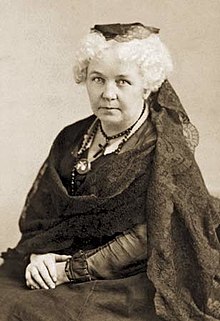
Back إليزابيث كادي ستانتون Arabic اليزابيث كادى ستانتون ARZ Elizabeth Cady Stanton AST Елизабет Кейди Стантън Bulgarian Elizabeth Cady Stanton Catalan ئیلیزابێت کادی ستانتۆن CKB Elizabeth Cady Stantonová Czech Elizabeth Cady Stanton Welsh Elizabeth Cady Stanton Danish Elizabeth Cady Stanton German
Elizabeth Cady Stanton | |
|---|---|
 Stanton, c. 1880, age 65 | |
| Born | Elizabeth Smith Cady November 12, 1815 Johnstown, New York, U.S. |
| Died | October 26, 1902 (aged 86) New York City, U.S. |
| Resting place | Woodlawn Cemetery, New York City, U.S. |
| Occupations |
|
| Political party | Independent |
| Spouse | |
| Children | 7, including Theodore and Harriot |
| Parent(s) | Daniel Cady Margaret Livingston |
| Relatives | James Livingston (grandfather) Gerrit Smith (cousin) Elizabeth Smith Miller (cousin) Nora Stanton Barney (granddaughter) |
| Signature | |
Elizabeth Cady Stanton (née Cady; November 12, 1815 – October 26, 1902) was an American writer and activist who was a leader of the women's rights movement in the U.S. during the mid- to late-19th century. She was the main force behind the 1848 Seneca Falls Convention, the first convention to be called for the sole purpose of discussing women's rights, and was the primary author of its Declaration of Sentiments. Her demand for women's right to vote generated a controversy at the convention but quickly became a central tenet of the women's movement.[1] She was also active in other social reform activities, especially abolitionism.
In 1851, she met Susan B. Anthony and formed a decades-long partnership that was crucial to the development of the women's rights movement. During the American Civil War, they established the Women's Loyal National League to campaign for the abolition of slavery, and they led it in the largest petition drive in U.S. history up to that time. They started a newspaper called The Revolution in 1868 to work for women's rights.
After the war, Stanton and Anthony were the main organizers of the American Equal Rights Association, which campaigned for equal rights for both African Americans and women, especially the right of suffrage. When the Fifteenth Amendment to the U.S. Constitution was introduced that would provide suffrage for black men only, they opposed it, insisting that suffrage should be extended to all African Americans and all women at the same time. Others in the movement supported the amendment, resulting in a split. During the bitter arguments that led up to the split, Stanton sometimes expressed her ideas in elitist and racially condescending language. In her opposition to the voting rights of African Americans Stanton was quoted to have said, "It becomes a serious question whether we had better stand aside and let 'Sambo' walk into the kingdom first." [2] Frederick Douglass, an abolitionist friend who had escaped from slavery, reproached her for such remarks.
Stanton became the president of the National Woman Suffrage Association, which she and Anthony created to represent their wing of the movement. When the split was healed more than twenty years later, Stanton became the first president of the united organization, the National American Woman Suffrage Association. This was largely an honorary position; Stanton continued to work on a wide range of women's rights issues despite the organization's increasingly tight focus on women's right to vote.
Stanton was the primary author of the first three volumes of the History of Woman Suffrage, a massive effort to record the history of the movement, focusing largely on her wing of it. She was also the primary author of The Woman's Bible, a critical examination of the Bible that is based on the premise that its attitude toward women reflects prejudice from a less civilized age.
- ^ DuBois Feminism & Suffrage, p. 41
- ^ Davis, Angela (1983). Women, Race & Class (First ed.). New York: Knopf Doubleday Publishing Group. p. 288. ISBN 978-0394713519. OCLC 760446965.